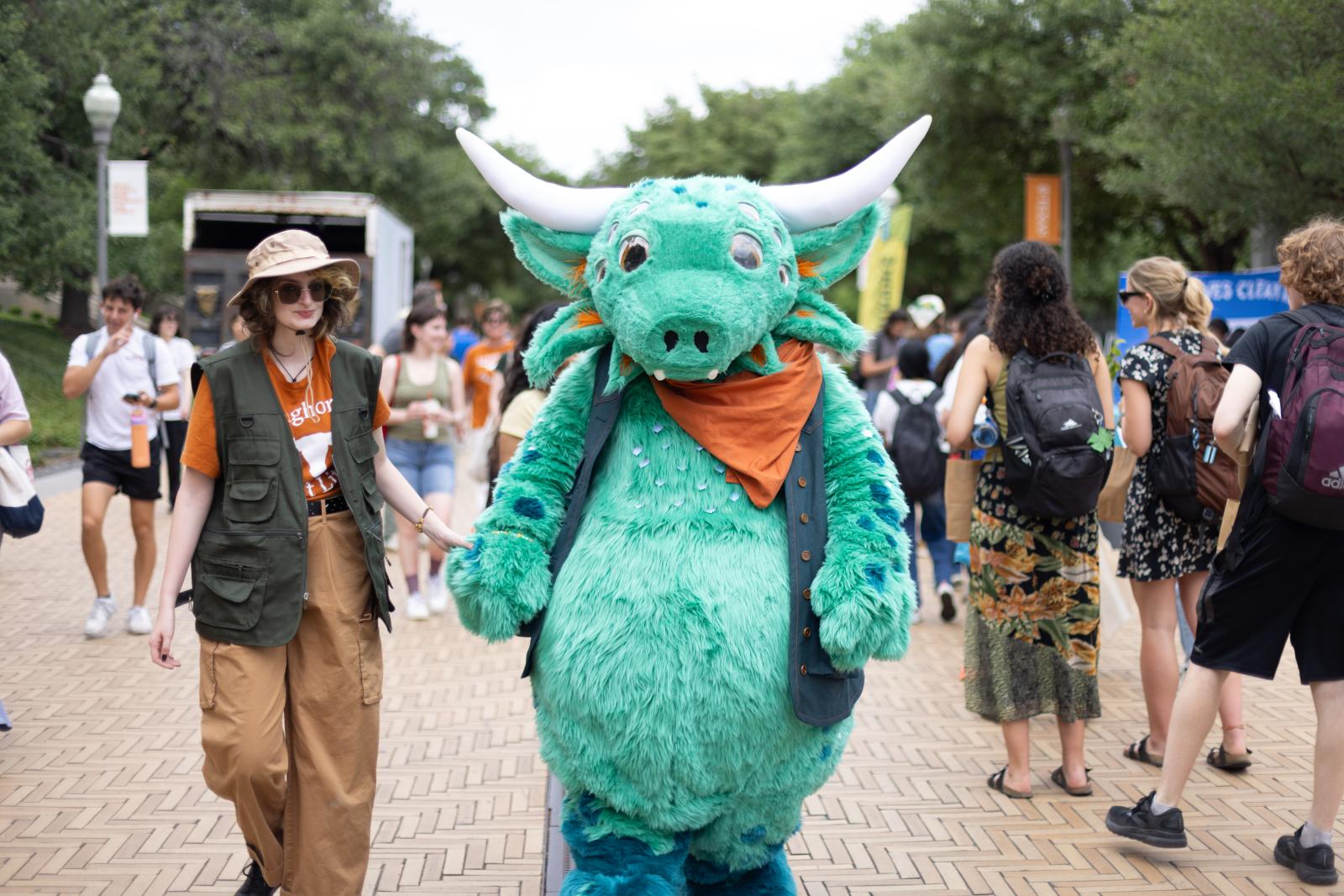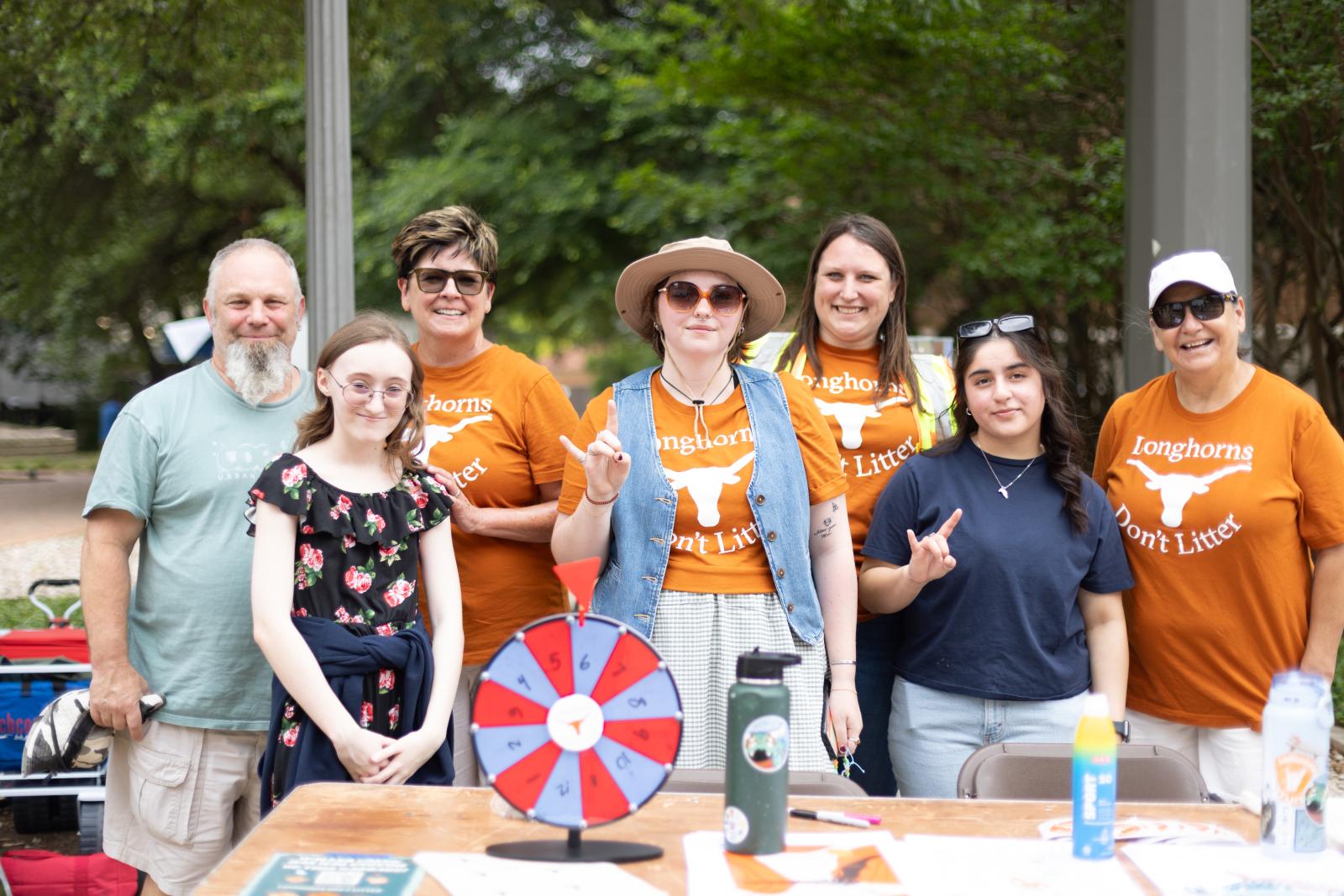“Creek Monster” aims to raise awareness for Waller Creek

Standing at almost 7-feet-tall, wearing a green fishing vest complete with a Longhorns Don’t Litter patch, the part-Texas blind salamander, part-longhorn Creek Monster, affectionately nicknamed Creeky, doesn’t just make people smile, he also carries an important message.
As the story goes, Creeky, who is millions of years old, immerged from his home in Waller Creek on Earth Day because of all the trash that’s ended up in the creek. He’s come ashore to spread awareness about the environmental impact littering and pollutants have on the creek’s water quality, and subsequent effects on the surrounding environment.
Austin has more than 50 watersheds. When it rains, pollutants like litter, fertilizer, pesticides and leaking vehicle fluids runoff into watersheds and then into the Colorado River. The University of Texas campus sits in the Waller Creek Watershed. That’s what inspired Valerie Salinas-Davis, an associate professor of instruction in the Moody College of Communication’s Stan Richards School of Advertising & Public Relations, to find a way to encourage her environmental communications students to think more sustainably.
“This has been an evolution and collaboration that has involved hundreds of students over the course of four years,” Salinas-Davis said.
The inspiration for Creeky comes from an abstract sculpture built by College of Fine Arts students for Waterloo Greenway Conservancy’s annual Creek Show in 2019.
“The sculpture is intended to be the spirit of the creek,” Salinas-Davis said.
Soon after, students in Salinas-Davis’s class developed the “Longhorns Don’t Litter” campaign. The campaign was spawned while developing outreach strategies for their class client, UT Environmental Health and Safety. Later, with the intent to protect Waller Creek on campus, and to ensure longevity without the support of the class, Longhorns Don't Litter and the Creek Monster mascot were institutionalized as a UT Environmental Health and Safety program.
“In 2022, I had them do market research and they surveyed nearly 600 students across campus on watershed awareness and it turns out students aren’t very aware of Waller Creek,” Salinas Davis said. She added that a surprising percentage even admitted to littering on campus.
Amber Matula, Longhorns Don’t Litter’s club president and Sustainability Studies major, took Salinas-Davis’s class in the fall of 2023.
“During the class we focused on a campaign and the campaign was Longhorns Don’t Litter,” she said. “Now that we’re a student organization, one of the things we always talked about was having a mascot for Waller Creek.”
As Longhorns Don’t Litter has grown, UT awarded a Green Grant to the class to turn the Creek Monster concept into something more tangible. With the help of a UT alumni-owned couture and fabrication studio called Hook & Eye, students have been able to see their mascot design come to life. Creeky made his first appearance at UT’s Earth Day Fair on April 22.
“Watershed protection is so important because those ecosystems are so sensitive,” Matula said. “It’s important to have an organization like this on campus because kids want to be involved in the community and to help the environment, so we want Longhorns Don’t Litter to be the keystone for organizations that want to do a creek cleanup or something similar.”
Salinas-Davis said that designing the mascot, as well as keeping Longhorns Don’t Litter active on campus, has been an interdisciplinary effort, some students studying communications, others focusing on sustainability, while some even major in business.
“To be in environmental communications, you have to be able to talk to scientists, figure out what resonates with their audiences, learn how to communicate what they’re working on,” she said, emphasizing why it’s so important for students of different educational backgrounds to learn the nuances of talking about environmental issues.
Matula hopes that even after she graduates, Longhorn’s Don’t Litter can continue to grow and that Creeky can keep spreading cheer and positive environmental messages on campus and beyond.
“I’d love for him to be an outreach figure for schools,” Matula said. “We’re taking him to Maplewood elementary this month. We want him to be a character that kids can see and relate to and understand why he’s there and why he’s needed.”
Salinas-Davis says that this fall, her environmental communications class client will be Dr. Stuart Reichler of the College of Natural Sciences. She says that through this partnership, the class will likely focus on continuing to raise awareness for waterways through a podcast.

